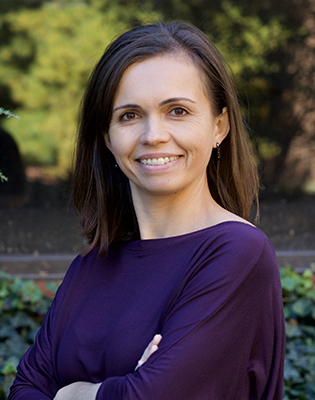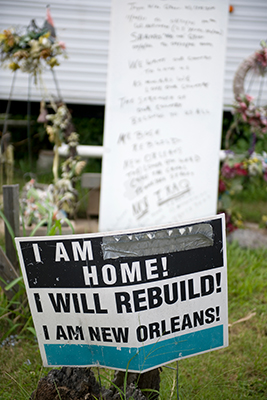After The Flood: Hurricane Katrina's lessons, 20 years later
Aug 7, 2025, 08:00 AM By
Twenty years on from the devastation of Hurricane Katrina, what lingers are the images. Rooftops barely visible above water. A submerged Ninth Ward. Families carrying their belongings through standing floodwaters. The swirling storm's eye, a perfect spiral, bearing down on the Crescent City. But the storm's impact, its real human, economic, and psychological cost, can't be seen from the air. And it didn't vanish with the floodwaters.
The landmark hurricane resulted in more than 1,800 fatalities and more than $125 billion in damage. Its consequences still echo in policy debates, disaster planning, and the lives of those forced to start over.
Few people have studied those consequences more closely than Tatyana Deryugina, an associate professor of finance at Gies College of Business whose research helps unravel the impact of disasters on our lives and economies.
"A lot of people don't think about natural disasters or air pollution as being economic issues, but economists have recognized for a long time that they’re disruptive to the economy,” said Deryugina. “We study how these phenomena affect economic performance, as well as our public health, because if we're not healthy, we can't be productive."
In tracing the long shadow cast by Hurricane Katrina, Deryugina's work challenges what recovery means - and who it reaches. Her research offers a clearer view into the storm's long-term effects and points to lessons still relevant today.
Economic Recovery Can Follow Rupture

One of Deryugina's major studies delivered a counterintuitive finding: not only did many residents’ incomes "bounce back," but the average storm victim eventually earned more than similar individuals who were never affected.
But, as she points out, this wasn't because the storm improved local economic conditions. Rather, it forced people to move. Uprooted from New Orleans, many relocated to stronger regional economies with more opportunity.
"Our hypothesis, which the data confirmed, is that people moved to stronger economies. New Orleans was not particularly thriving economically. On average, people went to places with higher earnings and were able to earn more themselves as a result."
Despite the gains, she cautions against mistaking dollars for well-being.
"Some of these earnings gains can be artificial. When the cost of living goes up and you have local inflation, your higher wages come with higher costs. So that's not a real increase in earning power. We did see some of that among victims who did not move, because the hurricane destroyed housing stock in New Orleans, which made the remaining housing more expensive."
Those counterintuitive gains, however, weren't distributed equally. One "big difference," Deryugina adds, was geographic - down to the zip code.
"People in the worst affected zip codes didn't see those long-term gains. By the end of our study period, they were back to where they were absent the hurricane - they didn't get that positive bump."
Health Outcomes Improved - Because of Where People Went
In another Katrina study, Deryugina and her collaborator, Gies Business Associate Professor of Finance David Molitor, turned their attention to a particularly vulnerable population: elderly and long-term disabled survivors of Hurricane Katrina. Surprisingly, they found that longer-run mortality rates for this group didn’t rise – they fell.
"I fully expected long-term mortality to rise," said Deryugina. "But starting the year after Katrina, we saw a persistent mortality decline. In fact, people who were in New Orleans before the storm hit were more likely to be alive at the end of the study period than those in our comparison group. That was quite striking to me."
As with income, the key mechanism was relocation. Displaced from their homes in New Orleans, many individuals found themselves in communities with overall healthier environments.
"New Orleans wasn’t a particularly healthy city. On average, people moved to healthier places, and the data shows that they lived longer as a result."
These findings complicate our assumptions about disaster vulnerability. They also raise larger questions about our system as a whole - how we protect at-risk populations before disaster strikes.
The System Works, But It’s Not Built for the Future

Deryugina's scholarship on the aftermath of Hurricane Katrina doesn't just focus on individual outcomes - it points to the broader strengths and limits of the US disaster response system. Despite the devastation of events like Katrina, the long-term perspective shows a surprising degree of resilience.
She credits much of that to a robust support system: federal aid, charitable giving, and community networks that help people find a hopeful future after a crisis. But while post-disaster aid appears to be relatively effective, she's more concerned about what happens before a storm makes land - especially with climate change accelerating.
"Once a disaster hits, our response is pretty good, but we need to be doing more before disasters strike in the first place. That's especially true given that climate change brings more frequent and severe disasters. As sea levels rise, some places might become very difficult or impossible to inhabit."
Deryugina expanded on these risks in the context of the 2024 Atlantic hurricane season, where she emphasized the growing toll of climate-fueled disasters and the urgent need for stronger pre-disaster policy. The stakes aren't limited to public policy: more Americans are living in disaster-prone areas than ever before, which means more lives exposed to threats of disaster and a harder time securing essentials like insurance coverage.
"There are a lot of barriers that put people at risk," said Deryugina, “which could be very expensive and strain our response systems. If more disasters are happening, our current capabilities might become inadequate for responding."
Redefining Resilience
Deryugina's scholarship reframes what recovery means: not a simple "return to normal," but as a reshuffling of risk, opportunity, and resilience. Hurricane Katrina's images remain with us, but so does the storm's test of how people, systems, and societies build back - and what happens after they do. She shows that the arc of recovery bends not just with income or risk, but with where people end up and what surrounds them. Deryugina has also weighed in on the future of disaster forecasting, highlighting how new tools like AI-powered weather models could reshape risk prediction and the insurance industry that depends on it.
As climate-driven disasters become more frequent and severe, her research reminds us that our systems must adapt, not just respond. It's not enough to clean up after a coming storm. The risks demand we prepare for who will be in its path and what they'll need to survive and rebuild. Resilience, it seems, is rarely evenly distributed.
Despite the challenges along the road ahead, Deryugina says that hope remains in moments of support that can go unnoticed.
"Charitable organizations go out and help victims. Families help each other. We don’t always observe these things, but underneath it all, there’s a lot of help and support that’s being provided.”
